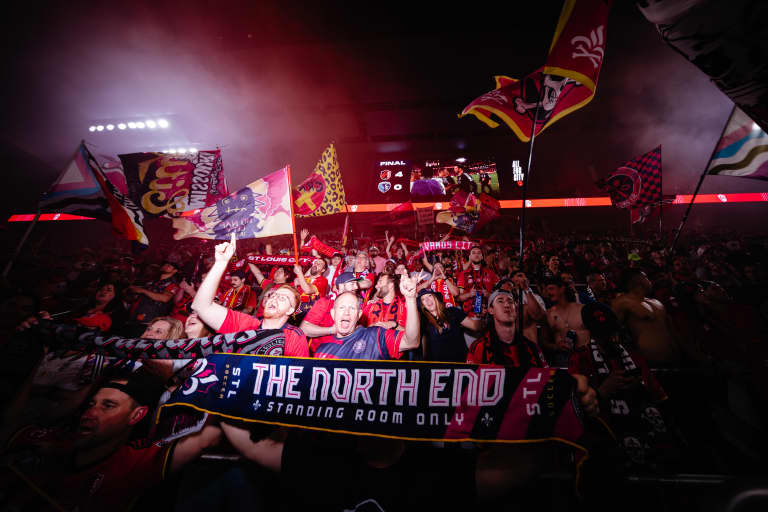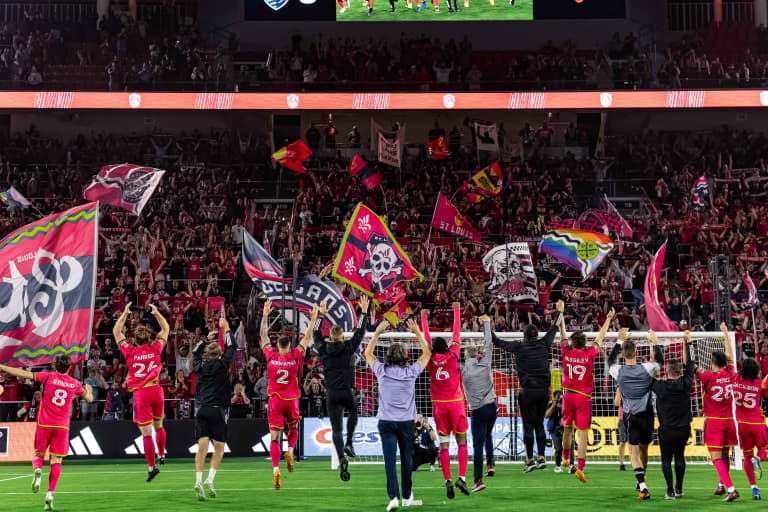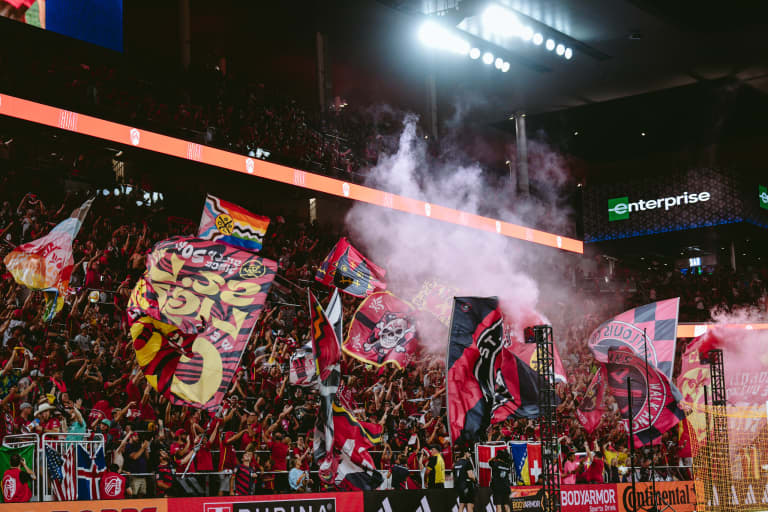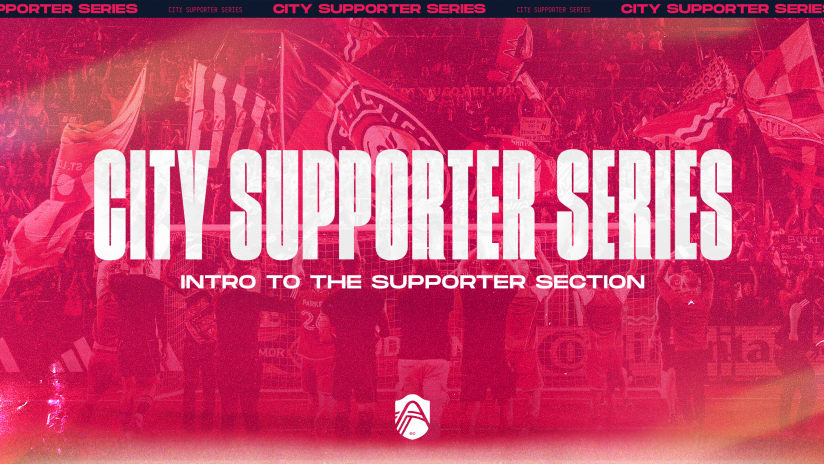Written by Michael Haffner
Para leer en español, ver aquí. | Za čitanje na bosanskom, pogledajte ovdje.
There are fans who want to sit and cheer passively while watching a soccer game. That’s all well and good. Then, there are the supporter groups.
Just as the players on the field are on their feet and in constant motion, so too are the supporter groups that make up the North End of CITYPARK. To put it simply: they show off their passion loudly and proudly.
Regardless of where you sit or stand in CITYPARK, you can see and most certainly hear the Supporter Section. The section is loud. It’s vibrant. It’s bursting with energy. The Supporter Section is made up of people from all walks of life – all different levels of fandom – but what brings them together is the shared goal to support St. Louis CITY SC. Future articles in this series will dive deeper into each of the different groups and people that make up this boisterous collective, but let’s first take a look into what makes a Supporter Section thrive.

Diverse Communities Forming a Collective
Since the MLS kicked off their first game in 1996, independent supporter groups formed to cheer on and show love for their teams. These groups bring the energy to the matchday experience, providing a heartbeat to the stadium and invigorating the team’s performance. They are able to exist independently in both leadership and financing and are recognized in a more official capacity by the club than just a group of friends. This allows for collaboration with their respected clubs to make a real impact on and off the field.
The Screaming Eagles in support of D.C. United and the Empire Supporters Group in support of the New York Red Bulls are two of the oldest groups in MLS. With 29 teams now in the league, every team is chockfull with groups that all cater to different personalities and walks of life. In some cities, several individual groups will form one overall group when they come together for game days, such is the case with “The Nordecke” in Columbus. Other times, those groups come together to create one space in the stadium, like what you have in Kansas City with “The Cauldron” or “The Chico Stand” in D.C. Currently, the Supporter Section at CITYPARK doesn’t have an official name, which has led to many referring to it as simply the North End.
Each individual group across the league is known for unique traits and traditions that define their membership, but they all come together to support their team through songs, chants, banners, scarves, merchandise, flags, signs and tifos. Most of these forms of support are very prevalent at every home game and many away games, but tifos are often a rare occurrence and reserved for special occasions or rivalry matches. Fans may remember the massive “Meet Me in St. Louis” tifo from CITY’s inaugural home match. Creating something of that size required dozens of supporters and took months of preparation, stitching, drawing, and painting – not to mention many people carrying it into the stadium. Although it only lasted for a couple minutes of recognition in CITYPARK, the pictures and videos of that moment continue to inspire the team and symbolize the next chapter in St. Louis’ soccer history.

A Unified Voice of Support
If there’s one thing that’s most commonly associated with supporter groups, it’s their voice. They are the loud ones. The ones who are always shouting their support for their team in unison each and every match.
Songs and chants come in many forms. Sometimes they are long-standing ones that many teams use but are slightly augmented and personalized. Other times they are original songs. And then some are familiar pop-songs that are reworked in clever and creative ways. Fans throughout CITYPARK quickly took to chanting a reworked version of The Cranberries 90’s alt-hit “Zombie.”
“He’s in your head, in your head-eddd
Bürki, Bürki, Bürki-ie-ie”
Rehearsing and memorizing chants is just one way they show support for their team. Many also use their voice to support their city and communities. These 501(c)(3) organizations raise money for nonprofit organizations and other fundraisers. Money is raised through the selling of shirts, flags, scarves, pins, patches, you name it. And generous supporters sometimes just contribute without anything in return. The money raised also supports tifos throughout the year since those are independently created and paid for by groups.
The concept of hardcore, fist-fighting, soccer hooligans is not something that many supporter groups in the MLS subscribe to. Sure, for 90+ mins there can be a heated rivalry, but members of opposing teams’ supporter groups will often hang out together, share a pre-match beer, and trade scarves. Trading scarves is an act of friendship and solidarity among groups, where one group’s scarf is exchanged with that of the opposing group. In many ways, it mimics the tradition of the teams at the start of a match exchanging banners. But on a deeper level, this simple act proves that soccer isn’t about creating division but rather bringing people together.
And that’s ultimately what’s at the heart of supporter culture. It’s finding your people… your tribe… your voice. Throughout this season, the St. Louis CITY SC players and coaches have expressed how much they love the support every game. How playing at home provides a competitive advantage because of the loud and supportive fans. It’s the strength in voice and numbers that transforms a soccer stadium into a fortress. And that all starts when the North End of CITYPARK comes alive in one unified front of support.






